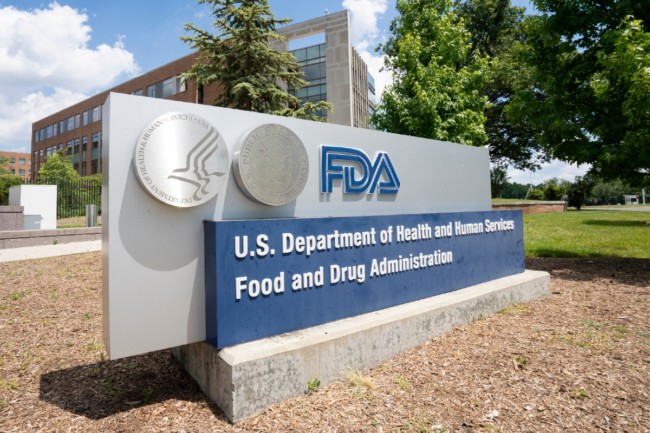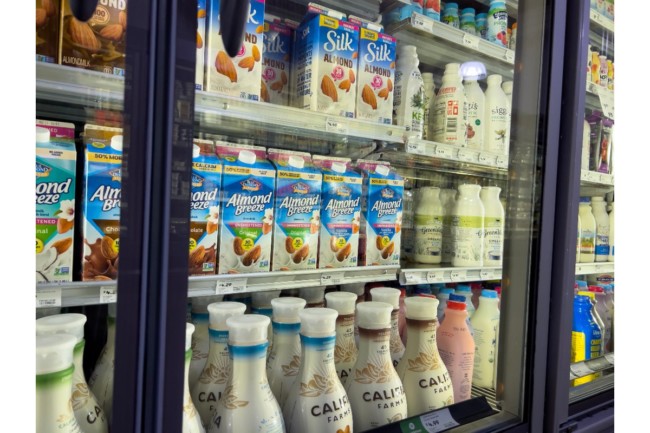Earlier this year, the US Food and Drug Administration (FDA) announced draft recommendations for the naming of plant-based foods that are marketed and sold as alternatives to milk. The draft guidance, “Labeling of Plant-based Milk Alternatives and Voluntary Nutrient Statements: Guidance for Industry,” recommends voluntary nutrient statements for the labeling of some plant-based milk alternatives.
The recommendations were developed to help address the significant increase in plant-based milk alternatives that have become available in the marketplace. The effort was to lead to providing consumers with clear labeling in order for them to make informed nutrition and purchasing decisions.
The FDA said that in addition to the increase in market availability and consumption, the variety of alternative products available in the marketplace has also greatly expanded from soy, rice and almond to include beverages made from cashew, coconut, flaxseed, hazelnut, hemp seed, macadamia nut, oat, pea, peanut, pecan, quinoa and walnut. Although these products are made from liquid-based extracts of plant materials, such as tree nuts, legumes, seeds or grains, they are frequently labeled with names that include the term “milk.”
More than 900 comments from industry voices have been submitted since the announced proposed recommendations. From Danone North America to the Plant Based Foods Association (PBFA), to the National Milk Producers Federation (NMPF) and International Dairy Foods Association (IDFA), industry heavy hitters have something to say.
 Photo: Tada Images - stock.adobe.com
Photo: Tada Images - stock.adobe.comDraft guidance lacking
Many dairy-centric organizations think the FDA’s draft guidance is not enough to prevent misleading labeling.
IDFA, Washington, DC, advocates that the FDA’s proposal to include a list of nutrients on the front of the container for plant-based milk alternatives is insufficient as a solution and onerous for consumers.
As a result, IDFA recommended the FDA include an on-package statement about the nutritional difference between milk and plant-based alternatives.
“For several years, IDFA has been advocating for the FDA to issue industry guidance that aligns with its standards that foods must be labeled in a truthful and non-misleading way while also advancing the nutrition security of all Americans,” said Roberta Wagner, senior vice president of regulatory and scientific affairs, IDFA. “For example, stating how nutrients differ from those found in milk in the manner proposed by the FDA would make it difficult for consumers to do side-by-side comparisons of nutrients in non-dairy beverages and milk and may further confuse consumers. Consumers should not need an advanced college degree in nutrition to make purchasing decisions.”
IDFA recently submitted comments to the FDA in support of the agency’s position that consumers need additional clarity on the labels of plant-based “milk” alternatives, such as “soy milk” and “almond milk,” to more easily discern when these beverages are nutritionally different from milk.
“As an alternative, IDFA recommends FDA include a simple declarative statement about the nutritional difference between milk and plant-based milk alternatives and encourage consumers to use the nutrition information on the existing Nutrition Facts Panel of non-dairy beverages to make purchasing decisions that are right for themselves and their families,” Wagner said.
The NMPF, Arlington, Va., said in comments submitted to the agency in July of this year that while the draft guidance on plant-based beverages acknowledges the public health concern regarding nutritional confusion, it falls woefully short of ending the decades-old problem of misleading plant-based labeling using dairy terminology. The organization emphasized the importance of transparent product labeling to ensure consumer understanding and informed purchasing decisions, and urged FDA to take prompt enforcement action against misbranded non-dairy beverages that resemble milk.
Confusion in question
Danone North America, White Plains, NY, one of the largest US dairy processors which also manufactures a variety of plant-based alternatives, including Silk, understands that consumers are increasingly looking for both dairy and plant-based options for a variety of reasons, including health, taste and sustainability, said Chris Adamo, vice president of public affairs and Ag policy, Danone North America.
“At Danone North America, we provide a variety of options across both our dairy and plant-based portfolio that satisfy different nutritional needs and consumer preferences,” he said. “In light of this, we support the FDA recognizing the mainstream acceptance of plant-based food and beverages and its guidance that plant-based beverages can be labeled with common and usual names, including those including the term ‘milk.’”
According to the PBFA, the evidence is clear: there is no confusion around the labeling of plant-based milks, and consumers are actively and intentionally choosing them because they are not animal-based, said Marjorie Mulhall, PBFA’s senior director of policy. “The proposed regulation to add nutrient disclaimers on plant-based milks is unprecedented and unique, potentially placing an undue burden on plant-based milk companies and causing confusion for consumers,” she said.
What’s more, Mulhall continued, nutritional equivalency is an inappropriate basis for distinguishing plant-based milk from animal-based milk, as different products serve a variety of intended uses.
“The standard of identity for milk contains no requirements concerning these ‘key nutrients,’ and different brands of cow-derived milks can have different nutritional content: One cup of whole milk and one cup of skim milk typically have different nutritional profiles,” she said. “As such, this recommendation raises more questions than it answers: What nutrient levels are considered ‘typical’? Should cow’s milk require such a disclosure statement if it does not meet that nutritional baseline? How do these standards apply to flavored cow’s milk products? This approach would sow confusion across the industry and impose a significant administrative burden on the FDA.”
With that in mind, Mulhall said, PBFA still believes that the proposition of voluntary nutrient statements does risk creating more confusion for consumers, as nutritional information is already available for all the products in question on the existing nutrition facts label.
The FDA affirmed in its recent “Draft Labeling Recommendations for Plant-based Milk Alternatives to Inform Consumers” that there is no consumer confusion around plant-based milk labeling, a conclusion that aligns with research PBFA has conducted over the years, Mulhall said.
“It is also significant that the FDA recognized that consumers understand that plant-based milk alternatives are distinct products and choose to purchase plant-based milk alternatives because they are not cow’s milk,” she emphasized.
Mulhall said consumers are increasingly showing their interest in plant-based milks, as reflected in their spending habits.
“Plant-based milk holds a dominant position in the plant-based foods industry, with US retail sales surging to $2.8 billion in 2022,” she said. “Our research shows that 40.6% of US households are buying plant-based milks, and an impressive 75.7% of consumers make repeat purchases, signifying that plant-based milk has become a household staple.”
Proposals that suggest plant-based milks should carry nutrient comparisons to cow’s milk imply that plant-based products are somehow inferior to their dairy counterparts, Mulhall said.
“This notion disregards the fact that many of the nutrients associated with animal-based milk result from fortification,” she said. “Not only is this suggestion discriminatory towards the plant-based sector, but it also poses a significant threat to the continued growth and innovation within the plant-based foods industry.”
 Photo: ColleenMichaels - stock.adobe.com
Photo: ColleenMichaels - stock.adobe.comNutrition matters
According to the draft guidance, recommendations suggest that a plant-based milk alternative product that includes the term “milk” in its name (e.g., “soy milk” or “almond milk”), and has a nutrient composition that is different than milk include a voluntary nutrient statement that conveys how the product compares with milk based on the US Department of Agriculture’s (USDA) Food and Nutrition Service fluid milk substitutes nutrient criteria. For example, the label could say, “Contains lower amounts of Vitamin D and calcium than milk.”
The FDA also said that dairy foods, including milk, are recommended by the Dietary Guidelines as part of a healthy eating pattern and contribute multiple key nutrients, including protein and vitamins A and B-12, along with calcium, potassium and vitamin D, which are currently under-consumed. In addition, Dietary Guidelines only include fortified soy beverages in the dairy group because their nutrient composition is similar to that of milk. However, said the FDA, the nutritional composition of plant-based milk alternatives (PBMA) varies widely within and across types, and many PBMAs do not contain the same levels of key nutrients as milk.
As studies have always suggested, getting enough nutrients in milk and fortified soy beverages is particularly important in helping children grow and develop. The argument maintains that many plant-based alternatives do not have the same nutrients as milk. Thus, the labeling conflict ensues as an industry issue on standards that needs to be addressed.
Matt Herrick, senior vice president, public affairs and communications, IDFA, said that no other type of food or beverage provides the unique combination of nutrients that dairy contributes to the American diet, including high-quality protein, calcium, vitamin D, potassium and health benefits, including better bone health and lower risk for Type 2 diabetes and cardiovascular disease.
“Understanding how nutrients in plant-based beverages compare to the well-established nutrient profile of cow’s milk is important information for consumers to have and our organization supports efforts to provide such clarity,” he said. “Our regulators must do a better job to ensure consumers have accurate nutritional information so they can compare nutritional equivalence as conveniently and effortlessly as possible.”

